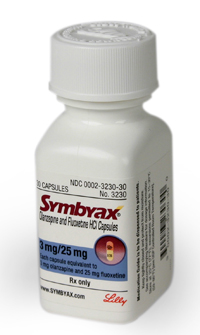Product
Symbyax (olanzapine and fluoxetine HCl capsules)
Approval Date
March 23, 2009 (new indication)
December 24, 2003 (original approval)
Release Date
Currently Available
Company
Eli Lilly and Company
Class
Combination of Atypical Antipsychotic and SSRIIndication
For the acute treatment of treatment-resistance depression.
Dosage forms: 3 mg/25 mg; 6 mg/25 mg; 6 mg/50 mg; 12 mg/25 mg; 12 mg/50 mg.
Active Ingredient
Olanzapine and Fluoxetine Hydrochloride
Agency Roster
GSW Worldwide
Marketing Strategy/Execution
Symbyax is now the first drug approved by the FDA for the acute treatment of treatment-resistant depression (TRD). With this FDA approval, clinicians in the United States have the choice to use the single pill option (Symbyax), or the two drugs (Zyprexa and fluoxetine) together, allowing physicians to tailor treatment to each patient’s needs. Neither Zyprexa nor fluoxetine are indicated as monotherapy for bipolar depression or TRD.
In addition to the new indication, Lilly has updated the Symbyax label to include additional information regarding weight gain, hyperglycemia and hyperlipidemia following the FDA’s review of clinical trial data that Lilly submitted to the FDA between August 2007 and July 2008. In the course of this review, Lilly provided data from several large databases, including analyses of placebo-controlled data, comparator-controlled data, long-term data and special populations, including antipsychotic-naive patients.
Physician Outlook
Symbyax use will be limited to Psychiatrists’ most severe depression patients (likely with co-morbid psychotic symptoms). Some psychiatrists will see the value in more convenient fixed dose proportions of Olanzapine and Fluoxetine Hydrochloride. Both agents are older and carry more pronounced side effect profiles; particularly weight gain and associated diabetes risk for olanzapine that may limit adoption.
— Geoff Penney, Vice President, GfK Healthcare
Also in the Pipeline (courtesy of Adis R&D Insight)
Drug: FK 949
Manufacturer: AstraZeneca/ Astellas Pharma
Indication: Bipolar depression
Active ingredient: Quetiapine
Phase: Launched
Source: Wolters Kluwer Health
Recent MM&M Coverage
Product News
Lilly says labeling for Zyprexa and Symbyax reflects recent data
Serotonin warning for users of SSRIs
FDA urges drugmakers to add new label info on antidepressant risks
FDA orders ‘black box’ warning for antipsychotic drugs
Pharmacology
Detailed clinical information withheld for review by MPR’sclinical advisory board and will be added as soon as it becomes available.
Clinical Trials
Detailed clinical information withheld for review by MPR’sclinical advisory board and will be added as soon as it becomes available.
Adverse Reactions
Asthenia, edema, weight gain, tremor, pharyngitis, increased appetite, somnolence, abnormal thinking, orthostatic hypotension; rare: neuroleptic malignant syndrome, tardive dyskinesia, hyponatremia, hyperprolactinemia, mania/hypomania, elevated liver enzymes.
Adults
Take once daily in the PM. Initially one 6mg/25mg cap; range: 6–12mg/25–50mg; max 18mg/75mg per day.
Children
Not recommended.Contraindications
During or within 14 days of MAOIs. Concomitant pimozide or thioridazine (may cause QTc prolongation).
Precautions
Cardio- or cerebrovascular disease. Hepatic impairment (monitor ALT/AST). Hypovolemia. Dehydration. Seizures. Diseases that affect metabolism or hemodynamic response. Diabetes. Narrow angle glaucoma. Prostatic hypertrophy. History of paralytic ileus or breast cancer.
Exposure to extreme heat. Dysphagia. Suicidal ideation. Reevaluate periodically. Write Rx for smallest practical amount. Avoid abrupt cessation. Elderly (esp. with dementia). Labor & delivery. Pregnancy (Cat.C). Nursing mothers: not recommended.
Interactions
See Contraindications. Do not start MAOI or thioridazine within at least 5 weeks of discontinuing fluoxetine. Increased CNS stimulation with tryptophan. May increase phenytoin, carbamazepine, haloperidol, clozapine levels. May potentiate other protein bound drugs and those metabolized by CYP2D6 (eg, tricyclics). May be potentiated by CYP1A2 inhibitors (eg, fluvoxamine). May antagonize levodopa, dopamine agonists. May be antagonized by carbamazepine, rifampin, omeprazole, other CYP1A2 or glucuronyl transferase inducers. Increased risk of bleeding with NSAIDs, aspirin, warfarin, others that affect coagulation. Orthostatic hypotension with antihypertensives, benzodiazepines, alcohol, others. Hyponatremia with diuretics. Monitor lithium, tricyclics, sumatriptan, phenytoin, warfarin. Caution with other antipsychotics, benzodiazepines, drugs that lower seizure threshold, other CNS drugs, hepatotoxic agents, anticholinergics, other forms of olanzapine or fluoxetine. Smokers may have increased metabolism.









